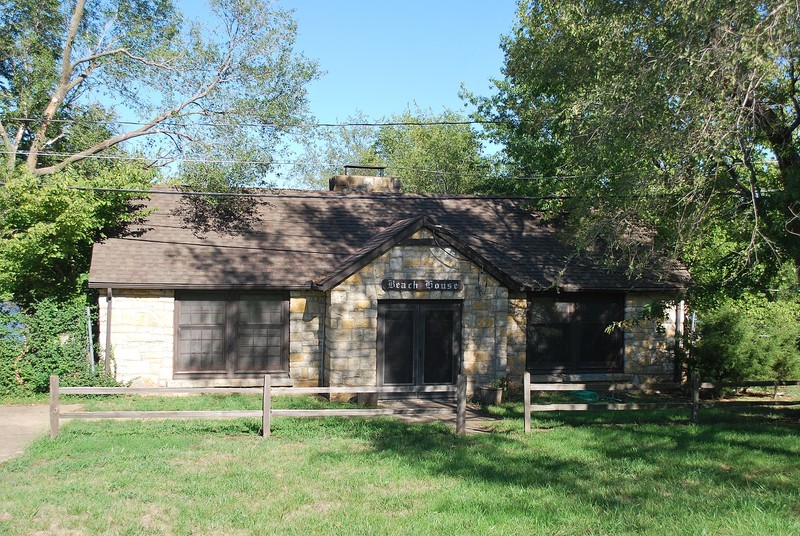WPA Beach House at Gardner Lake
Introduction
Text-to-speech Audio
The WPA Beach House at Gardner Lake serves as a reminder of the New Deal programs and their influence on the region during the Great Depression. In order to provide jobs while building local infrastructure, including more opportunities for outdoor recreation, the federal government built the dam that created Gardner Lake and then developed the surrounding property. The construction of this building was managed by the for-profit Gardner Lake Corporation, and was one of several structures in the area built under the auspices of the federally-funded Work Projects Administration (renamed in 1939 as the Work Projects Administration). This building was completed in 1938 as the lake and beach opened to the public. The limestone used in the construction of the building was quarried from the lake, and the entire project provided employment for over 200 workers.
Images
WPA Beach House at Gardner Lake

Backstory and Context
Text-to-speech Audio
The WPA Beach House (1937-1938) at Gardner Lake is made of Kansas Limestone as part of the larger Works Progress Administration's (WPA) effort to create a reservoir and recreational opportunities at Gardner Lake between 1935 and 1938. The Gardner Lake project represented the most comprehensive and expensive of the twelve public works projects the WPA funded in Johnson County. Demonstrating public-private partnerships that were often part of the WPA, the work was completed by the Gardner Lake Corporation, a for-profit company created specifically for this project.
Federal funds supported the creation of an extensive labor camp, complete with housing structures, dining halls, and more, which served as the temporary home to more than 200 men at the heart of the Great Depression. The WPA Beach House, Gardner lake, and the dam that created the lake survive as some of the few remaining examples of the WPA project period.
The Federal Government established the Works Parks Administration, or WPA, in 1935 (renamed in 1939 as the Work Projects Administration in 1939) to organize "light" public works projects for the unemployed. Although the WPA employed five million Americans between July 1935 and December 1938, workers earned wages far below the average. Still, for those suffering during the Great Depression, workers often took any job offered to them.
E.F. Alexander, a pharmacist, had the idea of tying into the federal drought relief programs to provide dependable and sanitary water systems for the residents of Gardner and surrounding agricultural areas. The federally funded drought relief programs associated with the New Deal plans of the 1930s (the Great Depression) made the idea of a reservoir to meet the City of Gardner's water needs an attractive and attainable possibility to the city's residents. But, Alexander also sought support from the private sector by spurring interest among the Gardner business community, which resulted in the founding of the Gardner Lake Corporation, which ultimately directed the lake project.
The Gardner Lake Corporation purchased the property for the reservoir project in 1934 and drafter plans to create a state park for recreation and fishing along with reservoir and dam construction plans. A court ruling in 1934 prevented the state from using public funds to purchase the property, so the city and corporation eventually took control and developed the land. By May 1936, the corporation employed 225 men who worked three daily shifts. The transient laborers, many of whom were desperate for work during the Great Depression, came to Gardner from all over the country. The workers lived in a camp that includes housing and mess halls and earned between $1 and $3 per week, and the workers received food, shelter, clothing, and medical care. The laborers completed the dam in 1937.
Construction on the WPA Beach House occurred sometime between the spring of 1937 and the summer of 1938. No plans suggest the builders intended for the house to function as a beach house, per se, but its completion coincided with the opening of the public beach in 1938. Hence, the beach house moniker materialized. The WPA Beach House is a rustic-style building type constructed by federal relief programs at parks throughout the nation during the 1930s and early 1940s. The WPA Beach House integrates native limestone construction with low, horizontal lines, appearing as a building that belongs at its site naturally; the transient laborers quarried the stone from the lake during its excavation.
The lake spurred private development around the lake during the 1930s and 1940s, notably the construction of summer cabins. But, over time, residential construction grew denser, with year-round, permanent homes arising with regularity. In spring, 1991 the Gardner Lake Association initiated efforts to preserve the WPA Beach House after the city announced plans to sell lake property and demolish the WPA Beach House. (Gardner operated the beach house from 1938 to 1989.) Residents supported the Association's efforts to save the building.
Cite This Entry
Powers, Mathew and Clio Admin. "WPA Beach House at Gardner Lake." Clio: Your Guide to History. February 8, 2022. Accessed April 22, 2025. https://theclio.com/entry/145888
Sources
Elving, Ron. "In The 1930s, Works Program Spelled HOPE For Millions Of Jobless Americans." NPR. npr.org. April 4, 2020. https://www.npr.org/2020/04/04/826909516/in-the-1930s-works-program-spelled-hope-for-millions-of-jobless-americans.
Johnson County Museum. "WPA Beach House at Gardner Lake." JoCo History (Johnson County Museum, Johnson County Library and fellow JoCoHistory partners). https://www.jocohistory.org/. Spring 1998. https://www.jocohistory.org/digital/collection/alb/id/234/rec/1.
Hagedqrn-Krass, Martha. "Nomination Form: WPA Beach House at Gardner Lake." National Register of Historic Places. nps.gov. 1992. https://npgallery.nps.gov/GetAsset/0fe6634c-b14d-4dfc-b16f-a546ce01e16d.
By Dlong417 - Own work, CC BY-SA 3.0, https://commons.wikimedia.org/w/index.php?curid=21190628

